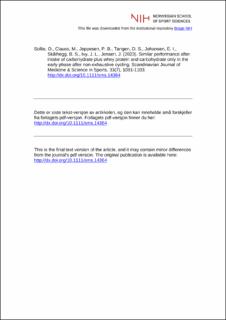| dc.contributor.author | Sollie, Ove | |
| dc.contributor.author | Clauss, Matthieu | |
| dc.contributor.author | Jeppesen, Per Bendix | |
| dc.contributor.author | Tangen, Daniel S. | |
| dc.contributor.author | Johansen, Egil Ivar | |
| dc.contributor.author | Skålhegg, Bjørn Steen | |
| dc.contributor.author | Ivy, John L. | |
| dc.contributor.author | Jensen, Jørgen | |
| dc.date.accessioned | 2024-04-16T08:55:05Z | |
| dc.date.available | 2024-04-16T08:55:05Z | |
| dc.date.created | 2023-04-12T16:25:24Z | |
| dc.date.issued | 2023 | |
| dc.identifier.citation | Scandinavian Journal of Medicine & Science in Sports. 2023, 33(7), 1091-1103. | en_US |
| dc.identifier.issn | 0905-7188 | |
| dc.identifier.uri | https://hdl.handle.net/11250/3126730 | |
| dc.description | I Brage finner du siste tekst-versjon av artikkelen, og den kan inneholde ubetydelige forskjeller fra forlagets pdf-versjon. Forlagets pdf-versjon finner du på onlinelibrary.wiley.com / In Brage you'll find the final text version of the article, and it may contain insignificant differences from the journal's pdf version. The definitive version is available at onlinelibrary.wiley.com | en_US |
| dc.description.abstract | Aim: The aim of the present study was to compare performance 5 h after a 90-min endurance training session when either carbohydrate only or carbohydrate with added whey hydrolysate or whey isolate was ingested during the first 2 h of the recovery period. Methods: Thirteen highly trained competitive male cyclists completed three exercise and diet interventions (double-blinded, randomized, crossover design) separated by 1 week. The 90-min morning session (EX1) included a 60 min time-trial (TT60). Immediately and 1 h after exercise, participants ingested either (1) 1.2 g carbohydrate∙kg−1∙h−1 (CHO), (2) 0.8 g carbohydrate∙kg−1∙h−1 + 0.4 g isolate whey protein∙kg−1∙h−1 (ISO) or (3) 0.8 g carbohydrate∙kg−1∙h−1 + 0.4 g hydrolysate whey protein∙kg−1∙h−1 (HYD). Additional intakes were identical between interventions. After 5 h of recovery, participants completed a time-trial performance (TTP) during which a specific amount of work was performed. Blood and urine were collected throughout the day. Results: TTP did not differ significantly between dietary interventions (CHO: 43:54 ± 1:36, ISO: 46:55 ± 2:32, HYD: 44:31 ± 2:01 min). Nitrogen balance during CHO was lower than ISO (p < 0.0001) and HYD (p < 0.0001), with no difference between ISO and HYD (p = 0.317). In recovery, the area under the curve for blood glucose was higher in CHO compared to ISO and HYD. HR, VO2, RER, glucose, and lactate during EX2 were similar between interventions. Conclusion: Performance did not differ after 5 h of recovery whether carbohydrate only or isocaloric carbohydrate plus protein was ingested during the first 2 h. Correspondingly, participants were not in negative nitrogen balance in any dietary intervention. | en_US |
| dc.language.iso | eng | en_US |
| dc.subject | endurance exercise | en_US |
| dc.subject | nitrogen balance | en_US |
| dc.subject | protein supplement | en_US |
| dc.subject | recovery | en_US |
| dc.title | Similar performance after intake of carbohydrate plus whey protein and carbohydrate only in the early phase after non-exhaustive cycling | en_US |
| dc.title.alternative | Similar performance after intake of carbohydrate plus whey protein and carbohydrate only in the early phase after non-exhaustive cycling | en_US |
| dc.type | Peer reviewed | en_US |
| dc.type | Journal article | en_US |
| dc.description.version | acceptedVersion | en_US |
| dc.source.pagenumber | 1091-1103 | en_US |
| dc.source.volume | 33 | en_US |
| dc.source.journal | Scandinavian Journal of Medicine & Science in Sports | en_US |
| dc.source.issue | 7 | en_US |
| dc.identifier.doi | 10.1111/sms.14364 | |
| dc.identifier.cristin | 2140382 | |
| dc.description.localcode | Institutt for fysisk prestasjonsevne / Department of Physical Performance | en_US |
| cristin.ispublished | true | |
| cristin.fulltext | preprint | |
| cristin.fulltext | postprint | |
| cristin.qualitycode | 1 | |
